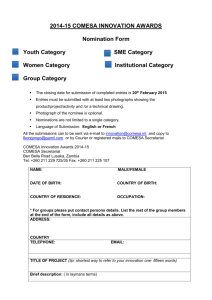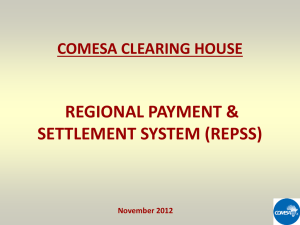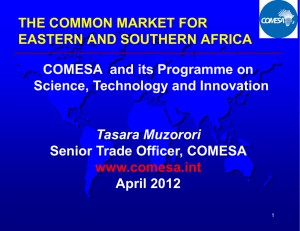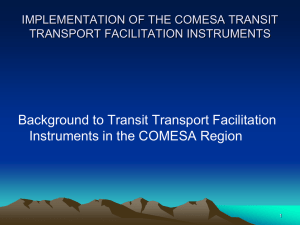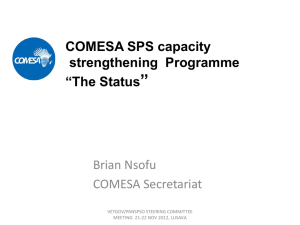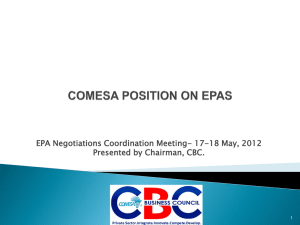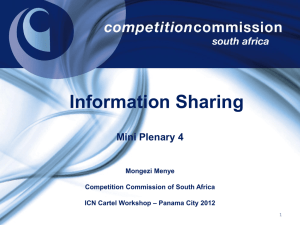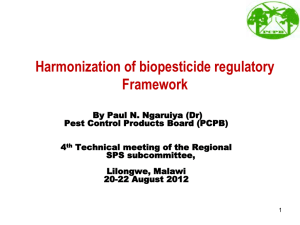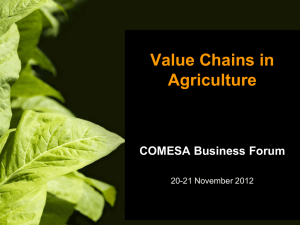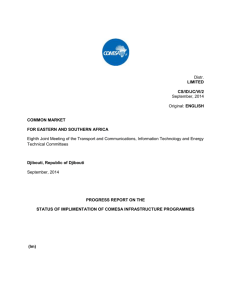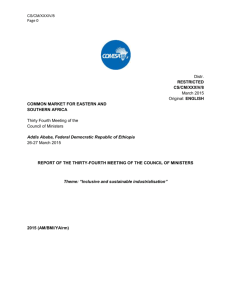COMESA, PROMOTING REGIONAL
advertisement
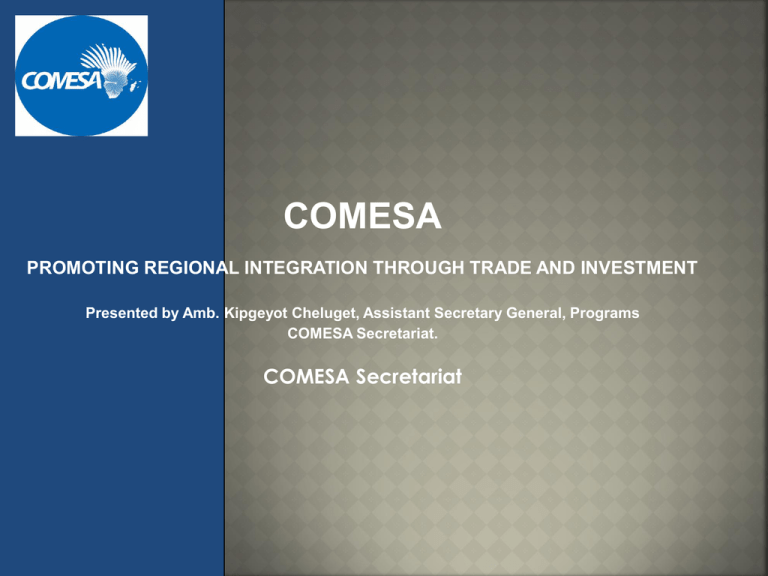
COMESA PROMOTING REGIONAL INTEGRATION THROUGH TRADE AND INVESTMENT Presented by Amb. Kipgeyot Cheluget, Assistant Secretary General, Programs COMESA Secretariat. COMESA Secretariat FOCUS ON TWO AGENDAS: COMESA- A REGION OF TRADE INVESTMENT OPPORTUNITIES INDIA – COMESA COOPERATION AND Membership : Total Area Population 19 countries- Burundi, Comoros, D. R. Congo, Djibouti, Egypt, Eritrea, Ethiopia, Kenya, Libya, Madagascar, Malawi, Mauritius, Rwanda, Seychelles, Sudan, Swaziland, Uganda, Zambia, Zimbabwe. : 12.2 million sq. Km 451 million GDP : US $ 450 billion: (Increase in Average Annual GDP growth : 5.08% from 3.51%(2010) Global trade for COMESA MS : Over US$ 244 BN (2010) Intra-COMESA Trade: US 18.4 BN(2011) Investment flows Total Imports Volumes : US $ 137 BN(2010) at 16% Total Exports Volumes : US $ 107 BN(2010) at 26% NB: : US $ 21,6 BN (2010) With an estimated population of over 450 million and a combined GDP of over USD 345 billion, the COMESA region is potentially one of the largest markets in the world Since its establishment, COMESA has made considerable progress towards economic integration including: trade liberalization, customs management, transport facilitation, trade and project finance institutional development, technical cooperation and capacity development. For example: Free Trade Area (2000); Duty Free Quota Free movement of Trade in Goods which comply to the COMESA RoO. Custom union (June 2009); Common External Tariff (0%, 10% 25%) to promote substantial movement of trade in goods within a Bloc- Regional Integration Common market 2025; Promote Substantial Movement of Goods and Services; The COMESA Secretariat facilitated and worked to the improvement of member states on ’ trade volumes and values by supporting the expansion of regional and international markets and production of diversified and competitive goods and services. There is, therefore, an expected turn in economic performance as the global economy continues to recover with improvements in global demand. COMESA region remains the largest recipient sub-region of FDIs: Why? Open economies: COMESA countries have already adopted the market liberalization at different levels, opening their markets to free movement of goods across the borders of 19 COMESA countries. Size of the market: With its 19 Member States and more than 450 million inhabitants (potential consumers), COMESA is the biggest regional trade bloc in Africa. COMESA Free Trade Area: increasing of the intra-regional trade within the region through trade liberalization and facilitation: Rules of Origin, transit traffic facilitation, Single Customs Document, One-Stop-Border Posts. Wider Free Trade Area with the implementation of the First Tripartite Summit Decisions towards the merger of 3 RECs into a single FTA (COMESA-EAC-SADC) REGION Percentage (2012) EU 31% CHINA 15% COMESA 11% USA 4% SOUTH AFRICA 6% JAPAN 1% INDIA 3% Rest of World 24% Turkey 2% UAE 3% Saudi Arabia 2% Switzerland 6 ROW 17 (2% in 2010) Products IMPORTS EXPORTS Agri.raw materials 2% 3% food 19% 16% Manufacturers 59% 27% 4% 15% fuels 12% 35% Other products 0.12% 4% Ores and metals REGION IMPORT VOLUMES EU 22% CHINA 11% SOUTH AFRICA 9% COMESA 6% USA 7% INDIA 5% (4% in 2010) RoW 26% UAE 5% SAUDI ARABIA 4% TURKEY 3% KUWAIT 3% COMESA, EAC and SADC – a total of 26 countries – make up the Tripartite With a combined GDP of USD 624 billion, and a population of 527 million Being 57% and 58% of Africa’s population and GDP; and 26/54 of Africa’s Member States It is a booming market already. Intra-tripartite exports increased from USD 7 billion in 2000 to USD 27 billion in 2008, and imports from USD 9 billion to USD 32 billion Returns on investment are highest in the world Infrastructure; utilisation of renewable and non renewable energy, nuclear and solar. Physical infrastructure- development of multi-model systems of transport(roads, rail, inland waterways, ports). PPP incentives Agro – industry and agro-processing; as, key sectoral industrial clusters;-hides and skins. Ie- set up of manufacturing and packaging plants. Real Estate Development; the lack of low level of affordable/low cost housing development in the region- a huge demand for domestic and commercial infrastructure within the region. New Technology that promotes Climate Change mitigation; innovative ways of doing business in the manufacturing sector using solar energy. Tourism; Countries that boost the tourism sector with a vast potential , such as , Kenya, Rwanda, Southern Africa-Malawi, Zambia. Potential areas of establishing tourism marketing in the region. The strong performance of intra-COMESA trade has been underpinned by rising intra-COMESA cross-border trade and investment. The private sector in the FTA countries has welcomed the FTA, and the Customs Union, for providing a larger market for their investment and exports. Intra-COMESA informal trade is estimated to amount to US$ 19 billion, an amount which exceeded the formal trade figure estimated at US$ 14.3 billion in 2008. The inclusion of the intra-COMESA informal trade in the total of intra – COMESA trade would raise trade volumes to USD 34 billion. Informal cross-border trade is therefore significant and factoring it into the planning and priorities of COMESA is of imperative necessity. Various systems have been put in place to promote monetary integration to support intra-regional trade. CAADP: (African Agriculture Development Program) Under CAADP, various programmes are underway; Guiding Investments in Agricultural markets in Africa; Improving Access to Agricultural Inputs- etc. ACTESA: (Alliance for Commodity Trade in Eastern and Southern Africa) This program is aims to Increase farmers productivity and incomes in the COMESA region, hence responding to existing challenges like trade related constraints, low productivity, technological and policy related constraints. COMESA Monetary Institutite: The program runs towards the establishment of a Monetary Union in the year 2025. The date for the Achievement of the Monetary Union was later changed to 2018 by the COMESA Council of Ministers in 2006. This program has the following stages: PTA: (COMESA Trade & Development bank) Provides trade finance to SMEs and Cross Border Traders in the region; contributes significantly to Private Sector Development. RIA: (Regional Investment Agency) Specialized agency which is a principal interlocutor on promoting investments in the region; is an information hub on investment news and investment opportunities. ; It is at the core of the implementation of the COMESA Common Investment Area with its role in building capacity of National Investment Promotion Agencies (NIPAs); CBC: (COMESA Business Council) CBC is a Business Member based Regional Private Sector institution of the COMESA. The objective is to promote collective engagement of the COMESA Private sector for effective regional integration, competitiveness, trade and investment. Additionally it is also to promote and defend the key interests of the private sector in regional integration, competitiveness, trade and investment. www.comesabusinesscouncil.org FEMCOM: The primary objective of is to promote the activities of Women in business in COMESA and beyond. ATI: (African Trade insurance). ATI provides investment and credit risk insurance to the financial institutions/ lenders, investors, manufacturers, importers and exporters, to enable accessibility of affordable financial resources for their economic activities. COMESA/LLPI: (COMESA Leather and Leather Products Institutive) India’s total trade with COMESA region has risen threefold: from $2.55 billion in 2004-05 to $8.48 billion in 2009-10), accounting for 38.2 per cent of India’s total exports to Africa, while the region’s share in the India’s total imports from the region stood at 13.1%. India’s imports from COMESA region were broadly listed as aluminium, copper, mineral fuel, coffee, resins, nuts, spices, sugar, leather, organic and inorganic chemicals and marine products. COMESA’s top exports to India from 2007 has been dominated by fuels, followed by manufactures, ores and minerals, agricultural raw materials and food items in that order. The pattern of the flow of exports from 2007 to 2011 also shows that of the region’s exports of food items, and ores and metal products, have tended to grow faster relative to the other exports over the years. The exports of Egypt and Libya to India have constituted mainly of fuels and ores and metals, while the exports of Madagascar, Malawi and Uganda are characterized mainly by food exports to India. The exports of Ethiopia, Kenya, Mauritius, Zambia and Zimbabwe are mainly manufactures. In all cases however, the countries altogether export ores and minerals as well as food items to India. is clear that COMESA is facing serious barriers to its exports. Even though raw m aterials and fuels exported by COMESA to the rest of the world are typically su bject to zero or to very low tariffs, there are still plenty of market access restricti ons faced by COMESA’s exporters, and these include: Marketing arrangements differ greatly among importing countries. COMESA Member States will typically be lacking adequate information about foreign markets, and that lack of information may be due to lack of transpare ncy on the part of the importing country. Negotiations with foreign countries may be constrained by the refusal of the ot her Party to offer reciprocity to COMESA Member States. Products other than raw materials and fuels continue to be subject to import d uties and even quotas. In negotiating better market access for their products, COMESA Member State s should target tariff escalation of importing countries. There are product-specific restrictions on some exports of COMESA Member St ates. Trade disciplines of importing countries may also be a major impediment to C OMESA exports. Those disciplines involve, in particular, rules of origin, SPS and T BT standards. Specific barriers affect exports of services, and should be addressed from a diff erent perspective to that of barriers to exports of merchandise. Importing country/customs area-specific issues will typically have to be taken i nto account. The COMESA region needs to build its productive capacities in various sectors such as in agriculture, mining, forestry, fisheries etc. The proposed cooperation should therefore take into account this consideration. This will requires that the COMESA region should not be drawn into the formation of an FTA for the purpose of tracking away primary products. The focus should rather be on how value should be added to primary products in order to promote trade. Turning to trade, a preferential agreement with India which is home to about 1.21 billion people, representing 17 percent of the earth’s population, could have a significant favourable impact on COMESA region if India removed the existing trade, health and technical barriers to imports from COMESA, and complementary measures were in place to address adjustment in COMESA and, given the different development levels, it were ensured that the arrangement is asymmetrical in the form of India offering duty-free-quota-free treatment to imports from COMESA. In terms of prioritization, more focus should rather be on supporting COMESA to enhance its productive capacity and international competitiveness in order for COMESA to have the ability to benefit from market access opportunities. The interventions required to assist build the productive capacity of COMESA and its competitiveness, include areas where India is a global leader, such as promoting Science, Technology and Innovation in a wide range of critical sectors including infrastructure, manufacturing, agriculture, health and education. India and COMESA have enjoyed good relations over the years, built on geographical proximity and history, and more recently on increasing trade and investment. In 2003, a memorandum of understanding was signed between India and COMESA covering the following areas: - Pharmaceutical products, Information technology, Agriculture, Biotechnology ensuring food security, Human Resource development (provision of technical training facilities, development of professional courses and curricula etc), Housing (including provision of low-cost housing units by the use of local available materials etc), tourism, Industry (including SMEs development), Energy, Infrastructure (Railways, Roads, Ports, etc), and Promotion of Cooperation between the Chamber of Commerce of India and COMESA Business Council. Of the 33 African LDC’s eligible for the Duty Free Tariff Preferential scheme of India (DFTP), 12 of them are COMESA member states. Non Eligible countries: Libya, Egypt, Kenya, Zimbabwe, Mauritius, Seychelles and Swaziland. Rationale ; To provide Duty Free Quota Free (DFQF) market access to Least Developing Countries on products comprising 92.5% of global exports of all LDCs. The product coverage ; 85 percent of products are duty free, 9 percent of products have a margin of preference and 6% of the product lines have no tariff preference. Most of the countries excluded from the preferential tariff scheme are mainly those that are the major trading COMESA member states with India. While India has a DFQF market access program, it is limited to LDCs and excludes some key exports from COMESA member states. The DFQF programs should be more comprehensive. Given that COMESA member states are far smaller economies that could not threaten India with an avalanche of exports, India could be invited to put in place a comprehensive DFQF regime covering all imports from COMESA. COMESA in return can include a regional COMESA market for Indian investment that can benefit from the protection of the COMESA Common External Tariff or similar tariff structures maintained by member states as well as support where appropriate in international organizations. India can be encouraged to export to COMESA capital goods and intermediate products, in line indeed with its export strategy that mentions machinery and equipment, and IT products. Small and Medium Scale enterprises constitute about 90% of the private sector of the member states, and provide most of the employment in the economies of member states especially among vulnerable sectors of society and are crucial players in the attainment of the public policy objectives of poverty eradication and wealth creation. India has a strong policy regime on SMEs. This can be a source of experience-sharing and partnerships with member states, as well as joint ventures in the private sector, in addressing challenges to development of SMEs in COMESA. Challenges faced: Inadequate credit facilities for SMEs resulting in low levels of capitalization or lack of trade finance; Poor management and business skills leading to high mortality rates; Poor quality products that may not be competitive; Low levels of technology and innovation; Information gaps regarding inputs and markets; Inadequate access to regional and global markets; Non-tariff barriers in export markets; and ;Inappropriate policy and legal regimes on SMEs. learning from the Indian experience and through twinning programs. Such programs could focus on twinning up local government authorities, civil society organizations, microfinance institutions, and other grass-root level institutions with Indian counterparts. Linking up SMEs with retail outlets in India could directly assist address market access constraints; mentoring and hands-on capacity building, to address the capacity of SMEs to meet market requirements and other regulatory requirements in export markets. joint ventures and preferential market access for products produced by SMEs can provide a much needed advantage, through for instance a DFQF regime that covers the products. These tend to be agro-based products and light manufactures. The COMESA prioritized clusters of textile and clothing, footwear, and agro-food products could be considered for such preferential market access in export markets of partners. There are also SME clusters in the fields of computer programming, research and innovation, and light manufacturing. It can be expected that Indian investment in COMESA, will be both in the manufacturing and services sectors, as well as the extractive industries. Regarding investment in the services sectors, infrastructure services should be prioritized, particularly information and communication technologies, and networks and sensors, transport, and financial services, as well as tourism; and should take the form of establishment of commercial presence through joint ventures. The next section deals with investment. INVESTMENT India should put in place tangible measures that increase India’s investment into COMESA, bearing in mind that COMESA offers vast opportunities and the Member States have ongoing programs to generate and attract investment; and joint ventures should be the preferred form of investment, which should take into account the priority sectors identified by Member States, particularly health and infrastructure, agro-food products, textiles, and leather products; Cooperation should be pursued in a range of areas set out the MoU and the Africa-India Framework of Cooperation, in a manner that recognizes the valuable contribution of COMESA and Africa at large towards India’s quest for global influence, and that taps into India’s leadership in areas such as technology and innovation through appropriate partnerships with India in both the public and private sector; THANK YOU FOR YOUR KIND ATTENTION. WWW.COMESA.INT
